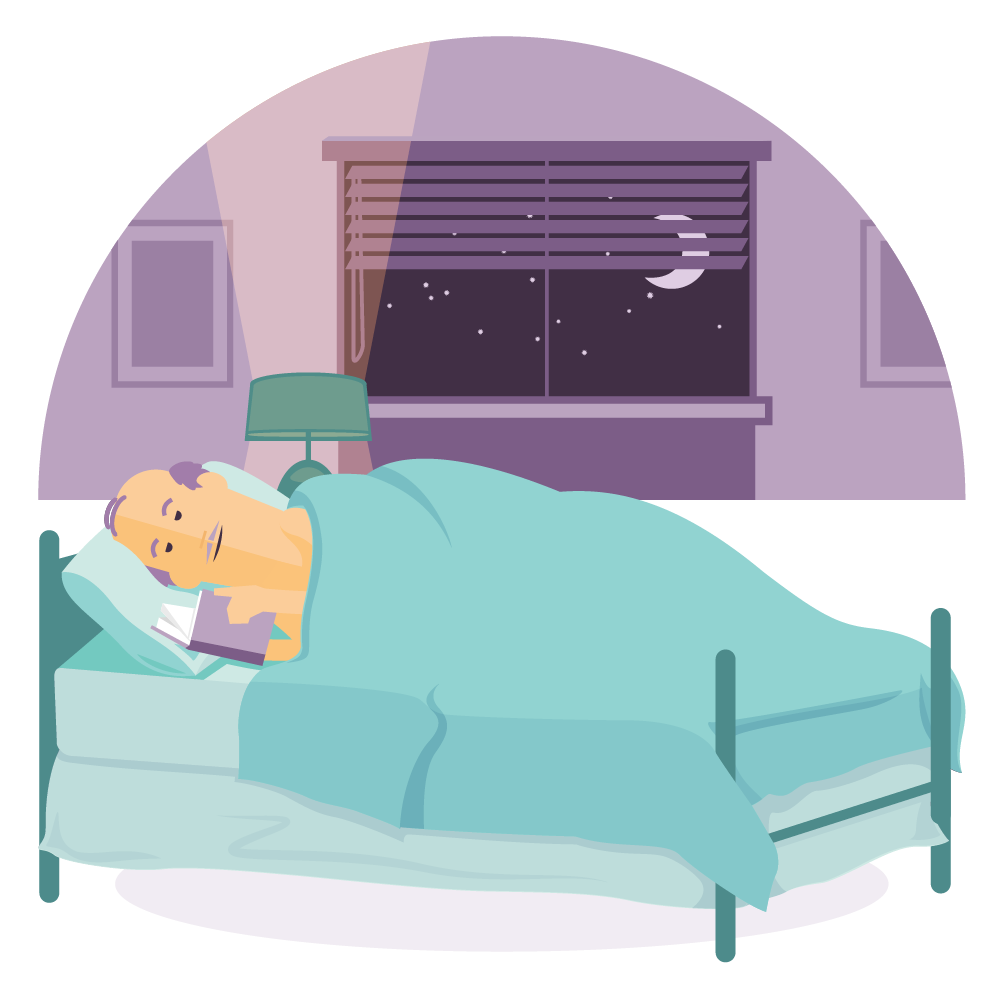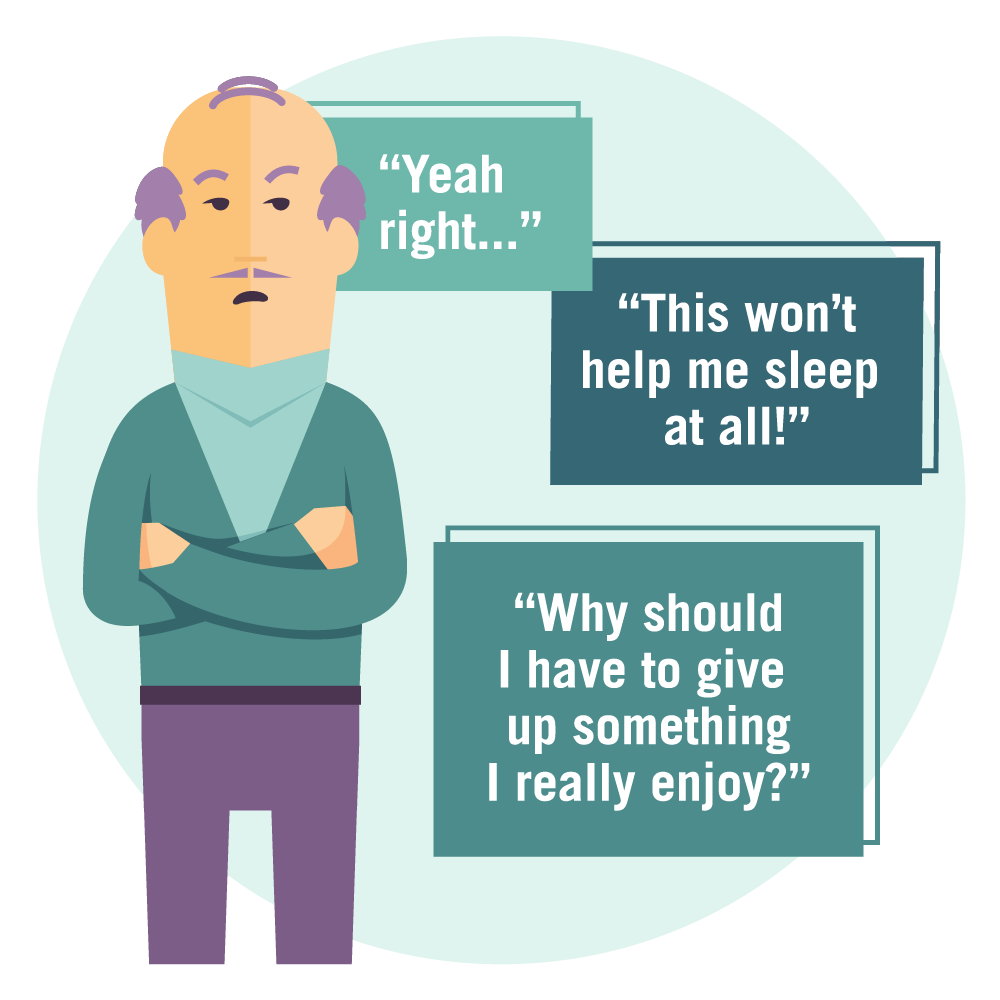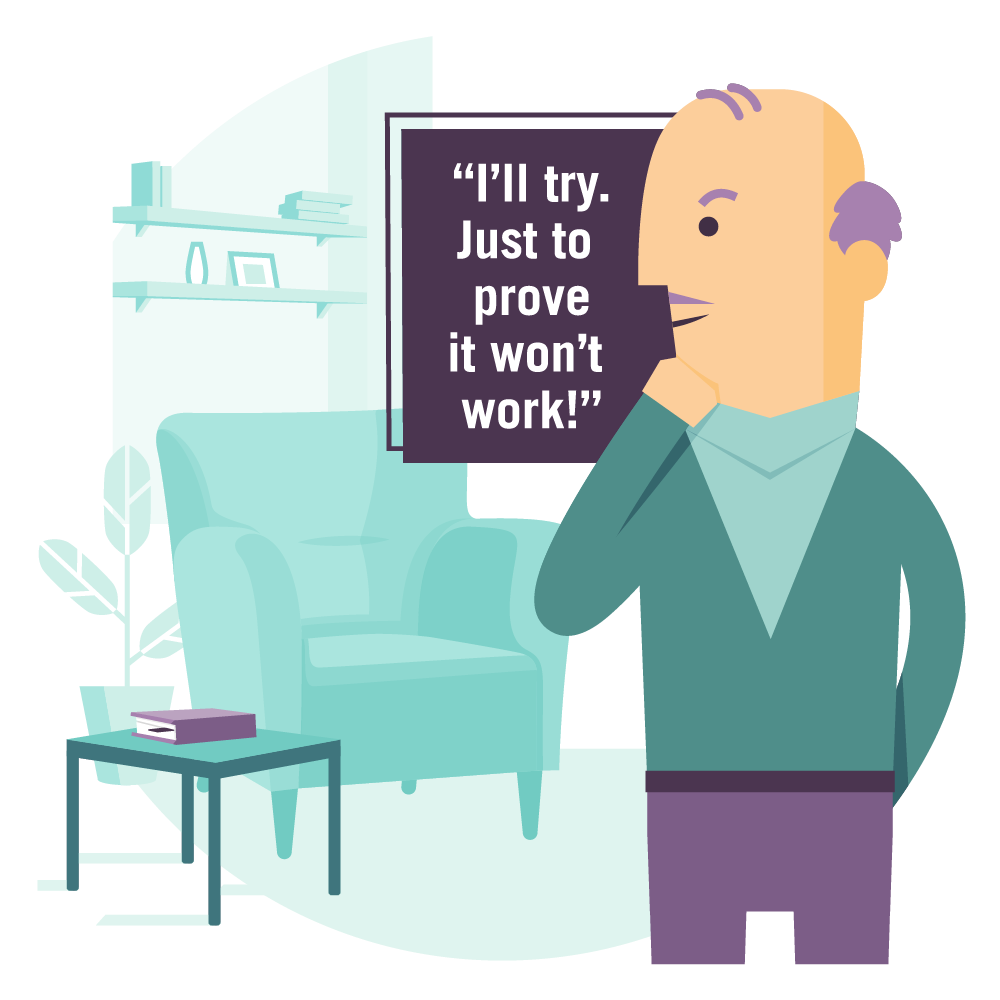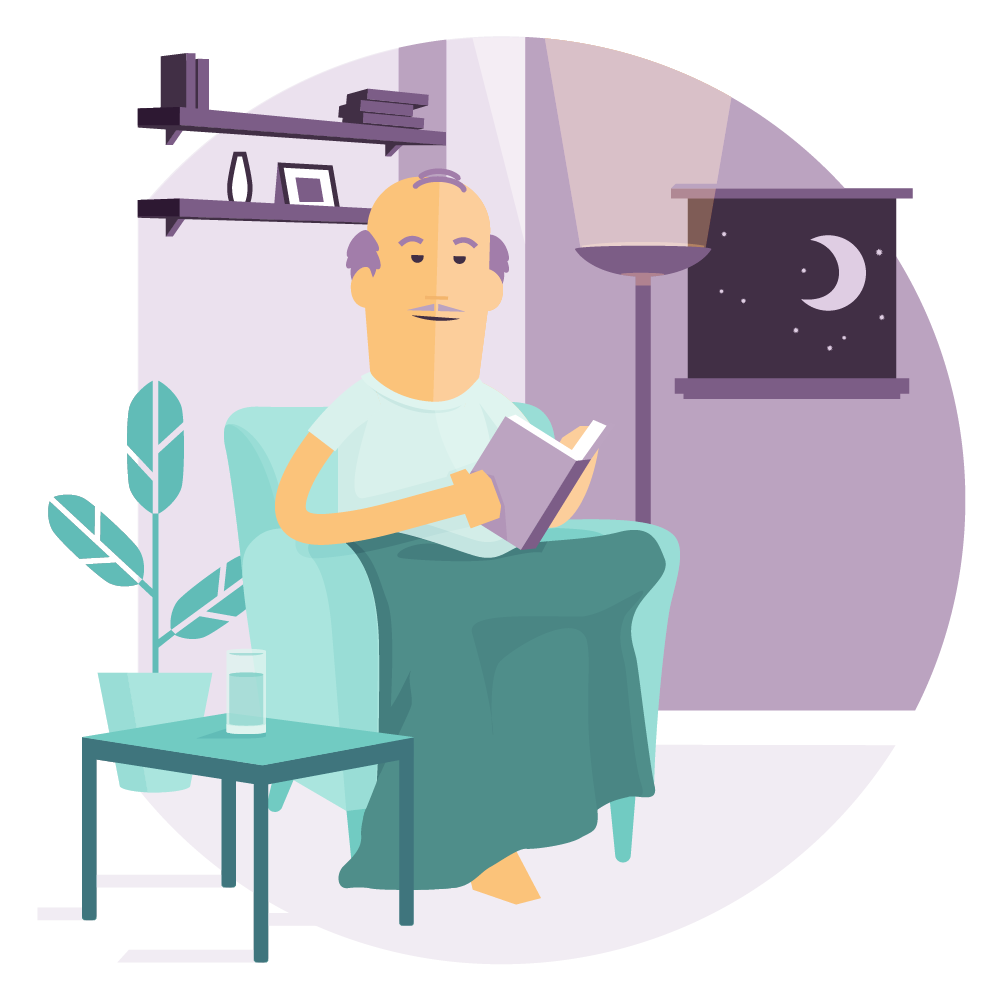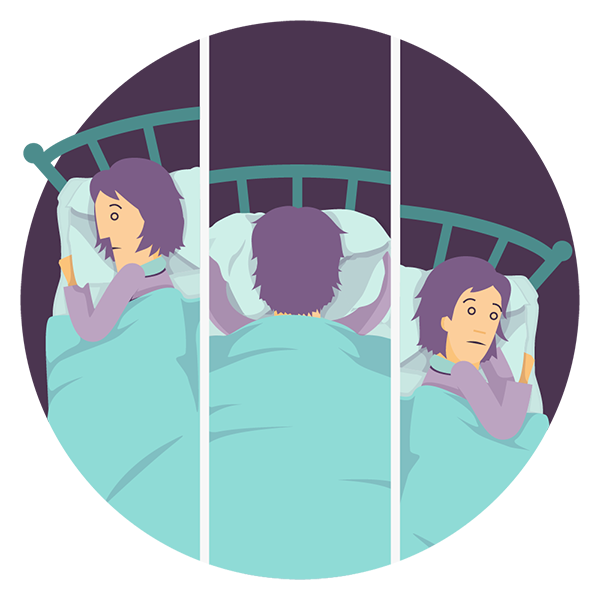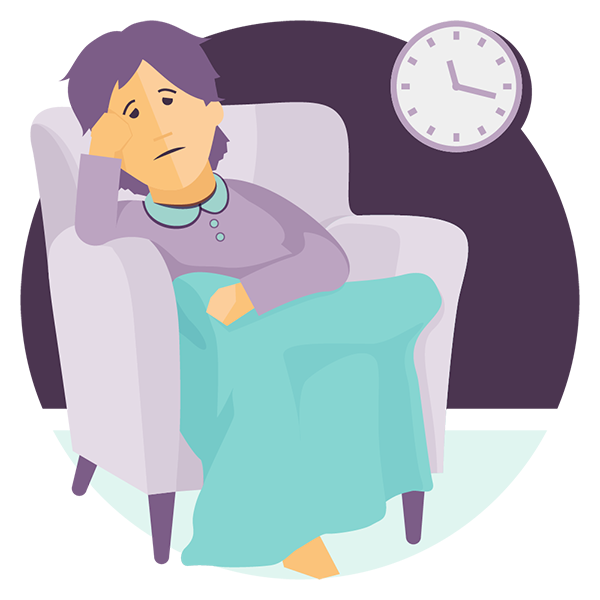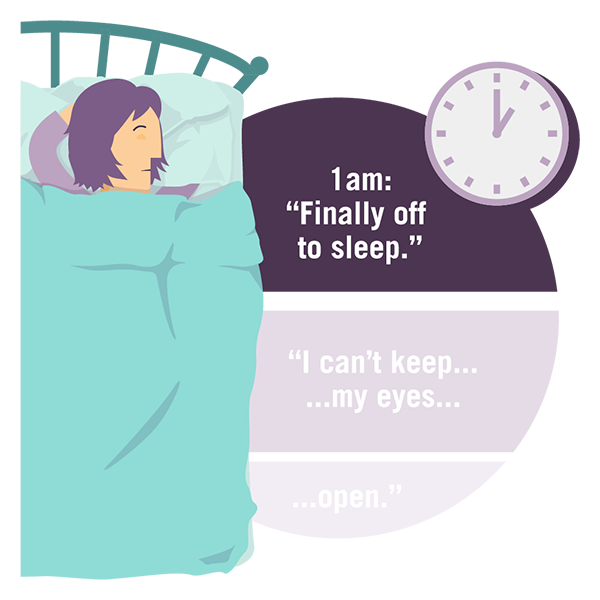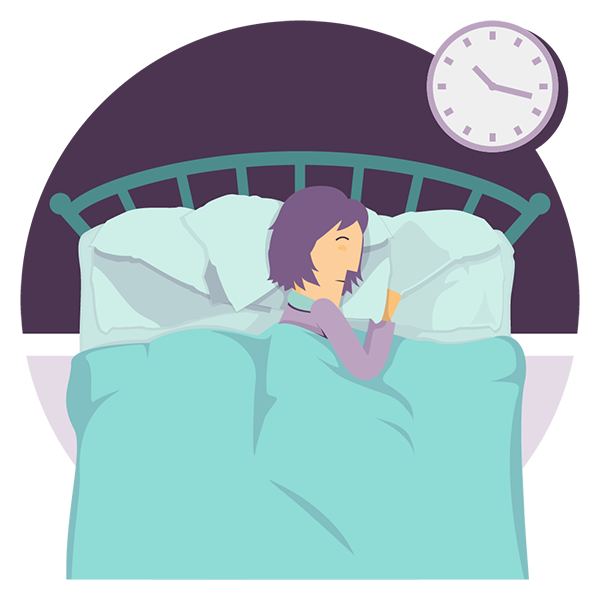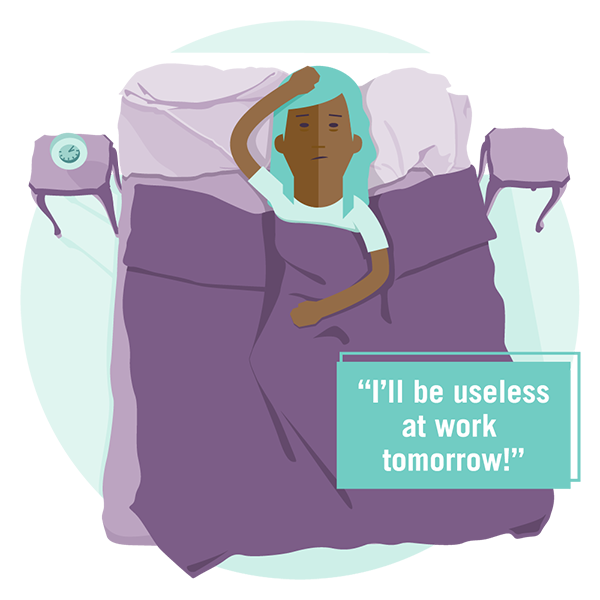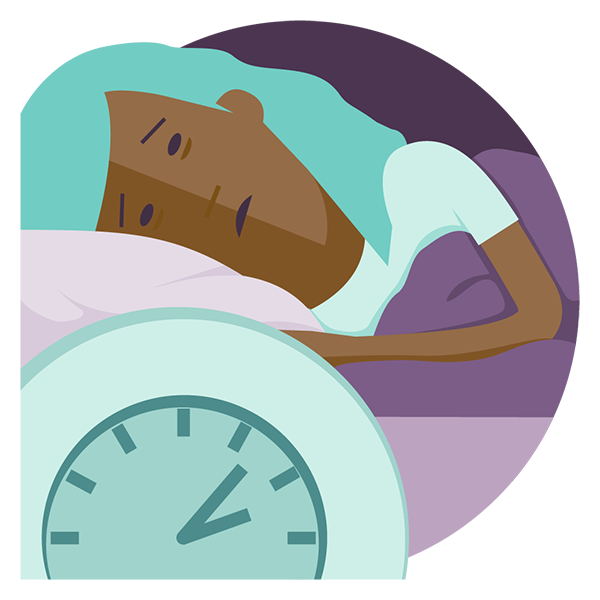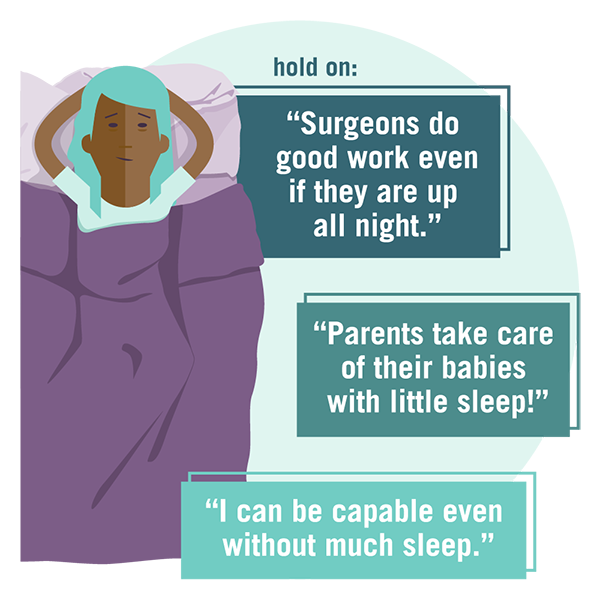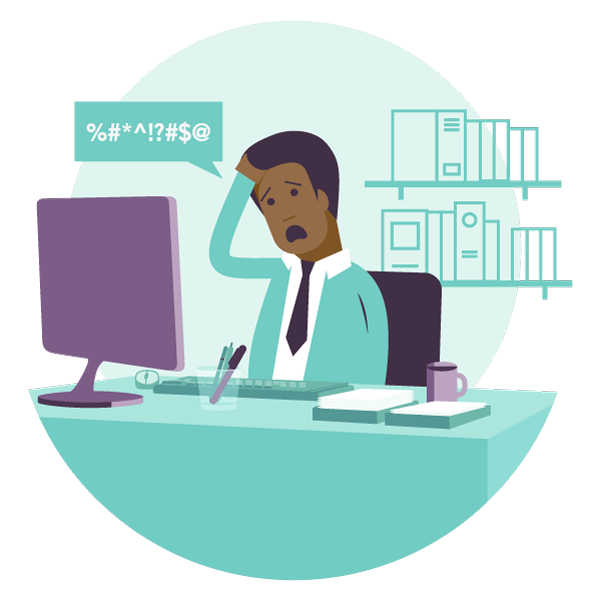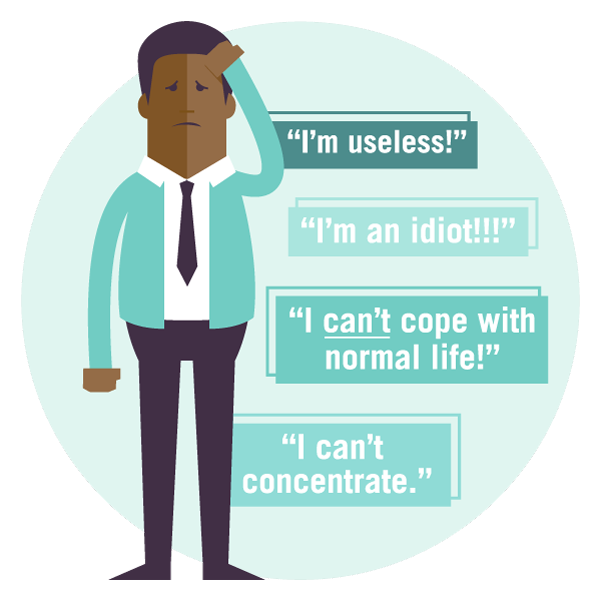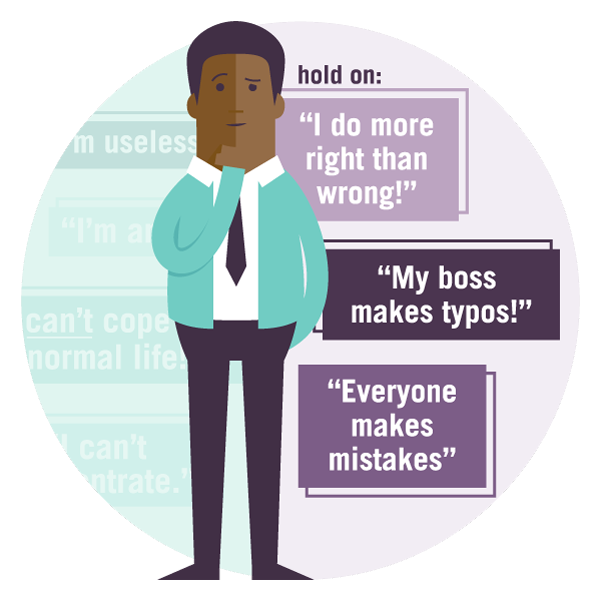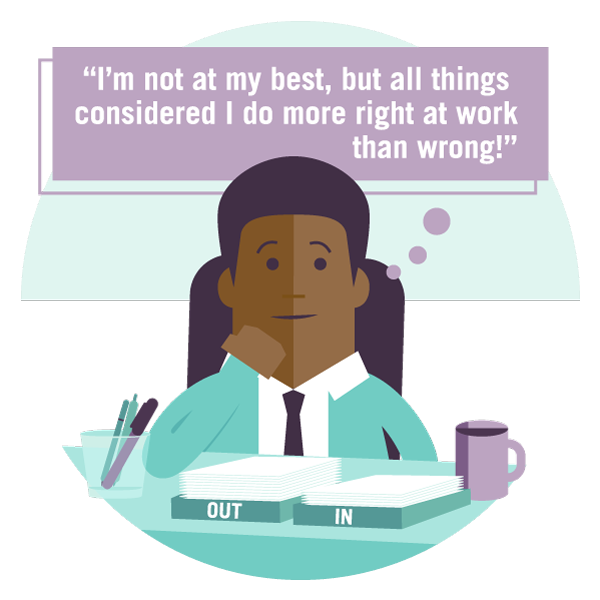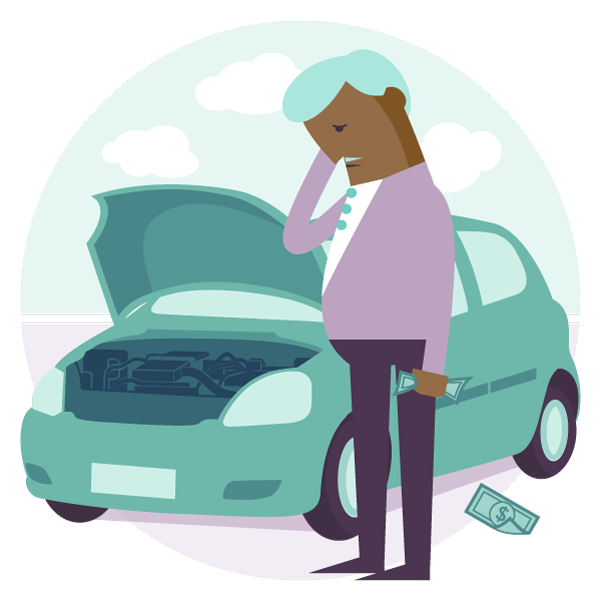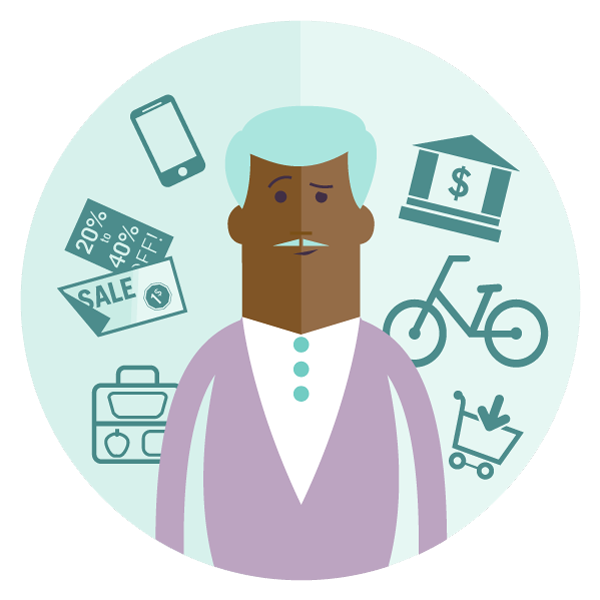Insomnia
Sleepless nights can have a negative effect on your concentration, judgment, and mood. The good news is that insomnia can be treated. Here you will learn more about insomnia and how to beat it.
You can use any lesson at any time. However, therapy for insomnia usually uses this order:
Learn the facts about insomnia -- what it is, what it feels like, and most importantly, how it's treated.
Good sleep starts with good habits! Learn a few basics that can improve your sleep routine and help you get the rest you need.
Anxiety creates muscle tension and makes it hard to relax. Learning to relax is a skill that will help you reverse the cycle of anxiety.
Learn about the types of medications used to treat insomnia.
Create a space that helps you feel sleepy. Learn why watching TV, reading or working in bed can stop you from falling asleep when it's bedtime.
Spend less time in bed so that you can sleep more! Learn how setting your sleep window will help you get the rest you need.
Beliefs about sleep often keep people tossing and turning. Learn how to challenge the myths about sleep that can keep you up all night.
In this unit, you will learn how you can feel better by challenging the thoughts that bring you down.
When you've got a problem, you need to do more than challenge negative thoughts. Here you'll learn how to cope in these situations.
Keep practicing. Download reusable worksheets and other tools to keep you going.
What is Insomnia?
6minEveryone has trouble sleeping now and again. But when a lack of sleep starts to get in the way of your work and relationships, it’s time to make a change. Insomnia can suck away your energy and drain your motivation. With time, you may end up feeling cranky, hopeless and negative. The good news is that insomnia is treatable. You can learn to regain control and sleep well again.
- The Facts
- The Sleep Cycle
- The Symptoms
- Treatment
! For your privacy, this site does not save what you type. To save it or have a therapist review it, please download your work at the end of your session.
The Facts
It’s Common
Almost everyone can remember a time when they slept poorly. Stress, a racing mind, or jet lag can keep you up all night. But for some people, insomnia can continue for months or years. Ongoing insomnia is one of the most common reported sleep problems. About 1 in 3 people suffer from some symptoms of insomnia.
It Can Happen to Anyone
Although some factors like age or gender can increase risk, insomnia can affect anyone. From young students to retirees, insomnia is a common complaint. Research has shown that women are more prone to insomnia than men. The risk of insomnia also seems to increase with age.
Sleep Basics
To understand insomnia, you need to learn about healthy sleep. During a good night’s rest, your body moves through 4 different stages of sleep. As you drift from light to deep sleep, your body moves through stages S1, S2, and S3. The last stage, called REM sleep, represents your deepest sleep. This stage is when you usually have dreams.
Your body moves through these stages in cycles. One cycle, from S1 to REM, takes about 90 minutes. It may be surprising, but you wake up after each cycle finishes. A good sleeper can wake up 5 to 16 times in a night! Most of the time people fall back asleep quickly and don’t remember waking up. They can then drift off into their next cycle. As the night goes on, it’s healthy to spend more and more time in deep REM sleep.
Quality vs Quantity
If you haven’t been sleeping well, you might think that you need a lot of sleep to feel better. The key to feeling well rested in the morning isn’t the amount of sleep you have, but the quality of it. A good night’s sleep doesn’t need to be over 8 hours long. But you do need to flow through your sleep cycles and get lots of deep REM sleep.
Many different things can interfere with the quality of your sleep. If you wake up for long stretches in the night, you might not get all your sleep cycles. These interruptions stop you from having all the REM sleep you need. Some medications can affect your sleep cycles as a side effect. You may spend less time in REM sleep or skip it entirely. Instead of getting your deep sleep, you might spend the night cycling between S1 and S2. Even some sleep medications can have this effect.
To treat insomnia, you want to get good quality sleep. Try to catch up on your sleep overnight. Don’t take lots of little naps throughout the day. If you can learn to fall asleep naturally, you are more likely to get a high quality sleep.
Causes of Insomnia
If you have insomnia, you may find it hard to fall asleep, stay asleep or sleep in until your morning alarm. Insomnia can have many different causes. Pain, anxiety and diet can play a role. Caffeine is known to keep people awake and boost anxiety. If you are sensitive to caffeine, don’t drink too much coffee or tea. Alcohol and cigarettes should also be avoided.
As insomnia continues, your thoughts about sleep can feed it. Worrying about getting enough sleep or what a lack of sleep can do, makes it harder to relax. The more worried you are about sleeping, the less likely you’ll be able to do it.
Whatever the cause of insomnia, the outcome is the same. When you don’t get enough good quality sleep, you become sleep deprived.
Symptoms of Insomnia
When you are sleep deprived, your body and mind can change in different ways.
When you aren't well rested, you may find it hard to focus and pay attention. Your judgment might feel off and your reaction time may be down. Over time, you may worry that your insomnia will never go away. Negative thoughts about sleep can leave you feeling depressed and hopeless.
Insomnia can make you feel tired, frustrated and angry. You may feel less motivated and powerless. Ongoing insomnia can boost your anxiety and lower your mood. In some cases, it can lead to depression.
Insomnia can drain your energy and tire you out. You may get headaches and feel heavy. Long term insomnia is known to make your eyesight and other senses less accurate. It can also make you more sensitive to pain.
People who suffer from insomnia tend to spend more and more time in their beds, trying to sleep. You may avoid making plans with friends or family because you aren't sure how you'll feel that day. With time, your relationships may suffer. You may spend more time alone and isolated. Some people turn to substances to help them sleep.
Treatments
The good news is that insomnia can be treated! Different kinds of therapy and medications can get you feeling better:
Kelty's Key is based on cognitive behavioral therapy. It is often used as the first line of treatment for insomnia. You will learn to reconnect your body with sleep and challenge unhelpful thoughts.
Different medications can be used to treat insomnia. It's important to know that some medications are not long term solutions. You should discuss the options with your doctor. It can take time to find the best medication for you.
Well Done. You're on Your Way.
You’ve taken the first step and learned about insomnia. Knowledge is important. Understanding what insomnia is and how it works will help you moving forward.
Sleep Hygiene
5minIf you haven’t been sleeping well, you may not have the best habits for sleep. A few small changes to your day and nighttime routines can make a big impact. These tips may not solve your more serious sleep problems, but every bit helps! Learn a few basics that can improve your sleep routine and help you get the rest you need.
- Good Sleep Habits
- Substance Use
- Daytime Routine
- Nighttime Routine
! For your privacy, this site does not save what you type. To save it or have a therapist review it, please download your work at the end of your session.
Good Sleep Habits
Research shows that a few changes to your day and nighttime routine can go a long way. What you do during the day, winding down at night, and in your bed can affect how well you sleep. Avoiding certain substances and medications can also help. Try to follow these guidelines and improve your sleep habits.
Use of Substances
Some substances and medications can make your sleep shallow and light. But you need good deep sleep to feel well rested. The first step to better sleep hygiene is cutting out these substances.
Many people believe that a nightcap will help them get a good night’s rest. But this old-fashioned remedy has not stood the test of time. Alcohol is not a good sleeping aid. Neither are many sleeping pills over the long term. They can disrupt your REM sleep and bring down your sleep quality.
Caffeine and nicotine should also be avoided late in the day or at night. These substances can keep you awake and make you jittery.
Your Daytime Routine
The next step to good sleep hygiene involves incorporating a few good habits to your day. Try to follow these guidelines:
- Get regular exercise. The morning is the best time. If you can only exercise in the afternoon, do so at least 2 to 3 hours before bedtime.
- Try to go to sleep at the same time each night.
- Wake up at the same time each morning. If you need a nap, take it in the morning. Don’t nap late in the day.
- Make sure you eat dinner at least 2 to 3 hours before bedtime.
- Take a hot bath about 2 to 3 hours before you want to sleep. Warming your body up and letting it cool down over a few hours can trick your body into thinking it’s getting sleepy.
Winding Down at Night
When you are getting ready for bed, it’s important to relax. Here are a few tips to help you wind down:
- Follow a routine to help you get sleepy, such as reading a book or listening to music. Avoid using any screens like a phone or computer before bed.
- Keep your bedroom dark, cool, and quiet. If it’s too light, try a sleeping mask. If noise is a problem, use earplugs, a fan, or a “white noise” machine or app.
- Use your relaxation skills.
When in Bed
The last phase of good sleep hygiene is what you do once you’re in bed. Try to follow these rules:
- If you tend to lay awake worrying about things, try making a to-do list before going to bed.
- If you wake up in the middle of the night, don’t eat a big stimulating meal. Stick to warm milk and honey.
- Don’t keep looking at the alarm clock! Watching the hours of the night tick by will make you more and more anxious. And when you are anxious, falling back to sleep will be even harder.
Tracking what you try can help you understand what works for you. Discover what builds your sleep drive and what gets in the way. Keep experimenting with these ideas, and you will soon be on your way to a more restful, restorative sleep.
Well Done! You're Ready to Improve Your Sleep Habits.
You've learned how to change your day and nighttime routines. A little can go a long way. Better sleep habits can make a big impact on your rest.
Relaxation
15minWhen you become anxious, your body gets ready for conflict. You breathe faster and shallower to take in more oxygen. Your muscles tense as your body gets ready to fight or run. When you are worried about something that might happen in the future, your body can stay tense for a long time. This can make your muscles hurt and feel sore. You may end up feeling exhausted and more anxious. Learning to relax can help you break this vicious cycle. You need to give your body and mind a rest.
- The Skill of Relaxation
- Deep Breathing
- Progressive Muscle Relaxation
- Overcoming Obstacles
! For your privacy, this site does not save what you type. To save it or have a therapist review it, please download your work at the end of your session.
Muscle Overdrive
If you came face to face with a wild animal, your body would get ready to either fight or run away. You would start breathing faster and your heart would start pumping like crazy. Your muscles would tense up, like a sprinter getting ready to run. When the danger was over, and you’d escaped, your body would calm down and go back to normal.
When you’re worried about something, your body gets ready in the same way. The difference is that you aren’t in danger. There’s no wild animal in front of you. Instead, your body is preparing itself for a wild animal that you might confront some time in the future. Because you can’t escape from a “what if”, your body doesn’t get to calm down and relax. You can stay ready for danger for a long time and send your muscles into overdrive. Learning to relax can help you give your body and mind some rest.
Relaxation as a Skill
Some people think that relaxation should be a natural process. “I’ll just sit down on the couch, turn on the TV, and do nothing.” But you might find that relaxing is actually harder than you think. Some people find that their worries take over when they try to relax. They might even feel guilty that they aren’t doing errands or taking care of things.
Learning to relax is a skill. It might not be enough to just distract yourself with a TV show or a hobby. Instead, you might need to practice specific ways to focus on relaxation. These techniques can help give you a break from the way anxiety affects your body. They can also teach you how to deal with worries that might come up when you’re relaxing.
When to Relax
A lot of people think you should relax when you are very anxious. But it’s really hard to relax when you are at the height of panic or worry. In fact, research shows that trying to relax during these stressful moments doesn’t work. It can actually make your anxiety worse!
Relaxation is not good for emergencies. You can’t relax away the intense physical symptoms of anxiety. Instead, you should practice relaxation regularly at times when your anxiety is under control. Make it part of your self care routine. With practice you can do relaxation exercises throughout your day. You can practice on the bus, at work or before you go to bed.
Types of Relaxation
There are lots of different ways to relax. Some focus on your breathing, others focus on your muscles. You might find that some techniques work better than others. Everyone is different. What works well for you might not work at all for someone else.
We’ll focus on two different ways to relax: Deep Breathing and Progressive Muscle Relaxation.
Deep Breathing
Babies breathe in a slow and deep way. As life becomes more stressful, people’s breaths tend to get quicker and shallower. This becomes a habit unless people learn to revert back to deep breathing. Some people master how to do this when they learn to sing or do yoga.
You can check your own breathing style by placing one hand on your chest and the other on your stomach. When you breathe in, notice which part of your body rises the most. If it’s your chest, focus on slowing down and deepening your breath. You want to arrive at the point where your stomach expands, but your chest barely rises. You also want to aim for about 8 seconds between in-breaths. Make sure to also slow down your out-breath to about 4 seconds.
Practicing Deep Breathing
You can practice deep breathing anywhere! It’s invisible to the people around you. You can practice while waiting in line, on the train or at the movies.
In the beginning, you can practice deep breathing for only 5 minutes at a time. As you progress, you can start using it anytime and anywhere you have a few moments to spare.
You can also use this technique when you notice that your breathing has become fast or shallow. Slowing your breathing sends a message to your brain that there is no danger. This allows your body to take a break and can reduce your fatigue over time.
Progressive Muscle Relaxation
This relaxation technique focuses on your muscles. The idea is to squeeze your muscles tight and then relax them. It might sound strange to tense up your muscles first, but this can make the relaxation feel deeper. Think of it working like a rubber band. The more you pull it tight in one direction, the further it snaps back in the opposite direction.
Progressive muscle relaxation can help you become more aware of your body. People often keep their muscles tight without noticing it. You might be tense even when you aren’t worrying! As you practice relaxation you’ll get better at recognizing the state of your muscles. Once you notice your anxiety and tension building up during the day, you can take steps to relieve it.
Practicing Muscle Relaxation
There are many different muscle groups where you may store tension. You shouldn’t try to squeeze all the muscles in your body at once! To do progressive muscle relaxation you need to work through the muscle groups one at a time. You can do it in any order. We’ll start from the head down to the toes.
Facial Muscles
Forehead
To tense the muscles in your forehead, lift your eyebrows up as much as you can. This should cause your forehead to wrinkle. Feel the tension in your forehead and scalp. Hold it for 5 seconds, then let go. Notice how the muscles relax when your eyebrows drop.
Eyes
Close your eyes and squint them as much as you can. At the same time, wrinkle your nose. Focus on the tension around your eyes, nose, and cheeks. Hold it for 5 seconds. Then stop squinting and wrinkling your nose, while keeping your eyes closed. Feel how the muscles around your eyes, nose, and cheeks relax.
Jaw
Make a big grin and clench your teeth. Also draw your mouth and chin inward. You should feel your mouth, jaw, and neck tense. Hold it for 5 seconds, then let go. Focus on how your jaw muscles and neck muscles relax.
Practicing Muscle Relaxation
Upper Body Muscles
Shoulders
Move your elbows up and back so that your shoulder blades gets pushed together. Focus on the tension this creates in your shoulders and back. Hold the tension for 5 seconds. Then relax your elbows and shoulders and focus on the relaxed feeling in your shoulders and back.
Chest
Take a deep breath and hold it in by tightening your chest. Focus on the tension in your chest as you pull it in. Hold the tension for 5 seconds. Then breathe out slow and focus on the looseness of the chest muscles.
Upper arm
Start with your dominant arm. Tense your bicep while keeping your forearm relaxed. You could also press your bicep into the side of your body. Focus on the tension in your upper arm. Hold the tension for 5 seconds. Then relax your arm and focus on the relaxed feeling in your upper arm. Now repeat this with your other arm.
Lower arm
Start with your dominant arm. Tense your forearm as much as you can. Make a tight fist. Keep your upper arm relaxed. If you have arthritis in your hands, make sure you do not keep your fist so tight that it hurts. Also if you have long fingernails, do not dig them into your hands. Focus on the tension in your hand and forearm. Hold the tension for 5 seconds. Then relax your forearm and hand and focus on the relaxed feeling in these body parts. Now repeat this with your other arm.
Stomach
Tighten your stomach muscles. Make them as hard as possible. Focus on the tenseness of these muscles. Hold the tension for 5 seconds. Then relax your stomach muscles and focus on how they change from tense to relaxed.
Practicing Muscle Relaxation
Lower Body Muscles
Buttocks and Thigh Muscles
Tighten your buttocks by squeezing them together as much as you can. Focus on the tension in your gluteal and thigh muscles. Hold the tension for 5 seconds. Stop squeezing your muscles together. Focus on the relaxed feeling in your gluteal and thigh muscles.
Calves
Start with your dominant leg. Lift your foot off the floor and point your foot. Tighten your lower leg. Focus on the tension in your foot and calf muscle. Hold the tension for 5 seconds. Then return your foot to the floor and focus on the relaxed feeling in your calf and foot. Now repeat this with your other leg.
Shins
Start with your dominant leg. Lift your foot off the floor and flex your foot. Tighten your lower leg. Focus on the tension in your foot and shin muscles. Hold the tension for 5 seconds. Then return your foot to the floor and focus on the relaxed feeling in your shin muscles and foot. Now repeat this with your other leg.
Overcoming Obtacles
Obstacles to relaxation vary from person to person. But some are pretty common. We’ve got a few tips to help you:
If you have an injury or feel pain for any reason, don't squeeze your muscles too hard. Pain will make your muscles tense up, making it hard to relax. If an area really hurts, skip making it tense and try to relax it directly.
While trying to relax, you may become distracted by worries. Don't try to argue with your worries or push them aside. This will only distract you more. The best approach is to bring your attention back to the relaxation exercise.
If you don't find deep breathing or progressive muscle relaxation effective, don't worry. There are other ways to relax. Ask your therapist for advice.
If you find it hard to stay awake during a relaxation exercise, try sitting up instead of lying down. It can also help to do your relaxation earlier in the day. It's easy to fall asleep if you do your exercise right before bed.
Try a Relaxation Exercise
It’s time to try relaxing! Many people find it useful to follow an audio recording. Everyone does relaxation a little different, so you might prefer some recordings to others. Try them out and see which ones you like.
Dr. Lori Brotto guides you through a body scan focusing on acceptance and awareness. This mindfulness exercise will take about 40 minutes.
Sean Butler leads you through a progressive muscle relaxation exercise. You can complete this practice in just over 11 minutes.
Dr. Theo DeGagne presents Quietude, with music by George Blondheim. This guide takes you through breathing relaxation, deep relaxation, and visualization. This exercise will take you about 20 minutes.
Flora Lung presents Beautiful Beach, a guided imagery relaxation exercise. This exercise is in Cantonese and will take about 20 minutes.
Flora Lung 提供一個啟導式想像鬆弛練習 ----- 美麗的海灘。練習以粵語進行,需時約20分鐘。
Poran Poregbal leads you through a body and mind relaxation guide. You will focus on your breathing, heartbeat, mind and sensations. This exercise is in Farsi and will take about 10 minutes.
پوران پوراقبال راهنمای شما میشود در یک تمرین آرامش یابی بدن - ذهن. شما تمرکز میکنید بر تنفس، ضربان قلب، و هیجانات ذهنی. این تمرین به زبان فارسی است و ۱۰ دقیقه به طول میانجامد
Andrea presents Safe Place, a guided visualization that promotes feelings of safety and comfort. This visualization is in Spanish and will take about 5 minutes.
Andrea presenta Lugar Seguro, una visualización guiada que promueve sentir seguridad y comodidad. Esta visualización es en Español y toma aproximadamente 5 minutos.
Good job! Time to Make Relaxation a Habit
Download Your Worksheet
Good job! You've learned how you can use relaxation to give your body a rest. Relaxation is a skill and the more you practice it, the more effective it may become. We have included a worksheet to record your daily practice of relaxation. Download your worksheet and record your practice for the next week. Share your experience with your therapist or healthcare provider.
Medications for Sleep
7minOver-the-counter and prescription sleep medications are a common way to treat insomnia. In this unit, you will learn how sleep medications work, the problems that can come up in the long term, and the right way to reduce your use.
- How Sleep Medications Work
- Types of Medication
- Side Effects
- Reducing Your Medications
! For your privacy, this site does not save what you type. To save it or have a therapist review it, please download your work at the end of your session.
Why Medication?
You may have tried, or are using, sleeping pills to help treat your insomnia. It’s important to not only treat your sleeplessness but the underlying cause as well. Some health problems make it hard to sleep. Poor sleep habits can also be a problem. Either way, it’s important to treat the real problem first.
Medications are best used for short-term sleep problems. Jet lag or trying to sleep during periods of extreme stress are good examples. Medications can also be helpful if other treatments haven’t helped.
Make sure you talk with your doctor about all the medications you might be taking. Even over-the-counter and herbal sleep aids!
You want to make sure you don’t have any medical concerns that make it unsafe for you to take medication. You also want to avoid interactions with other medications you might be using.
Types of Medication
Most sleeping pills are a type of drug called sedative-hypnotics. These drugs can make you feel groggy or sleepy. Let’s review some of the different kinds of sleep aids:
There are many drugs that you can buy without a prescription. You may have even seen them advertised on TV. Some are for sleep. Others are for problems like allergies or nausea. There is little evidence that these medications work well for chronic insomnia. Side effects like constipation, grogginess or confusion, can cause problems. Just because you buy them over-the-counter, doesn't mean you can't develop a tolerance!
Many herbal products are used for sleep problems. They include valerian root, passionflower, and chamomile. It is hard to find a good source of herbal remedies, so they are not recommended. There are few rules around the making of these products. Sometimes they do not contain any of the ingredients promised on the label!
Many drugs cause drowsiness and can help people with insomnia. Some of these drugs are also used to treat anxiety or depression. Make sure you ask your doctor if you have any questions. Sometimes people worry that their doctor gave them the wrong medicine. It is often the case that their medication can be used to treat insomnia and other concerns.
Problems and Side Effects
Like any medication, sleeping pills can have side effects or cause problems. Make sure you talk to your doctor or pharmacist about your particular sleep aid. Here are a few of the common concerns with many medications for sleep:
- You may develop physical dependence to the medication. This term means that your body needs to wean off of the drug slowly. Always talk to your doctor if you want to stop taking a drug. They will make sure that you do it safely.
- You may develop a psychological dependence. This phenomenon is often a bigger problem. It means that you no longer trust your own ability to fall asleep. Many people get anxious if they don’t have their medication with them, making sleep harder.
- You may develop tolerance to certain drugs and need to take more to be able to sleep.
- Some drugs leave you feeling hungover the next day.
- Daytime drowsiness and reduced alertness can be a problem.
- You may get greater quantity, but poorer quality sleep. Some medications interfere with deeper sleep. You might not feel rested because the medication only helps you get light sleep.
- Increased risks of interactions with other drugs or alcohol can occur.
- Some medications can interfere with breathing. This problem is especially important if you have asthma, sleep apnea or other breathing problems.
Why You Might Want to Stop Taking Medication
Learning to fall asleep naturally is more work than taking a sleeping pill. But there are some good reasons why it is worth putting in the effort.
You might be tired of spending money on sleeping pills. You might be concerned about long term effects. Or, maybe, you don’t want to have to depend on having them to get a good night’s sleep. Imagine not having to panic if you lost your pills on a trip, far from your family doctor and a new prescription!
Learning how to fall asleep without medication also feels like a huge accomplishment! Trusting that you will be able to fall asleep without using sleep aids can be a big relief.
Don’t Quit Cold Turkey!
It’s important that if you do decide to stop taking your medications that you stop safely. Quitting cold turkey can cause problems. Depending on the drug, some of the side effects include:
- Withdrawal effects
- Rebound insomnia
- Nausea
- Anxiety
- Headaches
- Irritability
- Tremors
- Seizures
If you experience severe symptoms you should always see your doctor or go to the emergency department.
Some people find that their sleeping problems are worse than ever when they stop taking sleep medication. This frustrating turn of events is called rebound insomnia. Don’t be fooled into thinking that you can’t sleep without drugs if it happens to you! Rebound insomnia may be uncomfortable, but it’s temporary.
You can reduce or avoid many of these symptoms by slowly tapering your medications.
Reducing Your Medications Safely
To reduce your medications safely, you must go slowly. In some cases, you may need medical supervision. For instance, if you take sleeping pills every night, or if you’ve had a bad reaction when you stopped before. Having support can also help if you feel nervous about reducing your medication. Don’t be afraid to reach out for help if you need or want it.
Here are the steps you should take if you want to reduce your medications safely:
- Every medication is different. Make an appointment with your doctor to talk about the best way to taper down. Your doctor can make a schedule that is best for you depending on your dose, how long you’ve been taking the medication, and your reaction.
- If you feel good, keep going. If you have trouble, go back to your doctor. You may need to slow down. Getting the right pace can help you get through this with as few side effects as possible.
- Remember that rebound insomnia is normal. Stick to the plan and your sleep should get back on track. Talk to your doctor or therapist if you begin to feel discouraged.
- Focus on your rewards. No more running out to get new prescriptions! No more money spent on sleep aids! No more feeling like sleep is beyond your control!
- Don’t keep the rest of your pills once you have tapered down! Keeping them on hand “just in case” can prove to be too tempting. It can also derail your hard work if you don’t trust that you can manage without them.
Good Job. You're Exploring Your Options.
When you know what medication can and can't do, it can make a world of difference. Understanding how to use sleep medications safely can help you regain control over your rest.
Creating a Sleep Sanctuary
10minMany people use their bedroom for more than sleeping. Some watch TV in bed. Others might have a desk where they study or pay bills. Readers love to snuggle up with a good book before they go to sleep. If you don’t have insomnia, these activities are okay. But if you find yourself tossing and turning, you may need to make some changes to your nighttime routine.
- Pinpoint Your Sleep Disruptors
- Retrain Your Body
- Tackle Obstacles
- Stay on Track
! For your privacy, this site does not save what you type. To save it or have a therapist review it, please download your work at the end of your session.
Sleepy Anywhere But Your Bed
Many people with insomnia find that they can fall asleep anywhere but in bed. Sleep comes easy on the couch, a comfy chair or even on the bus! The trouble is that when you get under the covers, your body seems to wake up.
If you toss and turn when you crawl into bed, you may need to make a few changes. We’ll show you how to teach your body to associate your bed with sleeping.
Sleep Disruptors
You may not realize it, but your body makes connections between where you are and how you feel. Your body may associate your couch with feeling relaxed or your work desk with stress. If you can’t sleep in your bed, it’s likely that your body doesn’t connect your bed with feeling sleepy.
If you use your bedroom as a place to read, study or watch TV, your body may learn to be alert in bed instead of tired. Tossing and turning in bed can be really frustrating. If you do this often, your body may associate your bedroom with feeling agitated or restless.
To sleep well at night, you want your body to feel sleepy when you get into bed. Your body needs to associate your bed with tiredness. You may not realize it, but you may be doing activities in bed that disrupt this connection. Some of the things poor sleepers might do in bed that ultimately make it harder to fall asleep include:
- Watching TV
- Reading
- Staying in bed if you can’t fall asleep in 20-30 minutes
- Lying in bed too long when you wake up in the morning
- Eating
- Texting
- Reading your phone
- Working on your laptop
- Talking on the phone
- Arguing in your bedroom
Retraining Your Body
The good news is that you can learn to retrain your body to feel sleepy when you’re in bed. You need to make a few changes, but with some patience, you will start sleeping better.
The first step is to only use your bedroom for sleep or sex. No reading or writing. Pack up the television and move it to another room. No texting your best friend, work or studying.
Your body must start associating your bedroom with sleep, not activity.
This change may be challenging if you live in a studio apartment or dorm. It can also be tough if you have roommates and your bedroom is the only place for privacy or quiet. In that case, try to set up a separate area to read or work. It’s even better if you can use a divider or somehow separate your sleeping area from your work area.
To help your body associate your bed with feeling sleepy, you can follow a few simple rules.
Rule 1: Make Sure You’re Sleepy
The first rule is simple. Don’t go to bed unless you are sleepy! When people have trouble sleeping, they often think they should go to bed early to try and get more sleep. It’s better to do the opposite!
Wait until you’re completely worn out before crawling into bed. Your chances of falling asleep quickly, in less than 20 minutes, will increase. The more often you can fall asleep in your bed, the better. Your body will start associating your bed with falling asleep.
Over time, you should start to feel sleepy when you crawl into bed. This change is a key to treating insomnia.
Rule 2: No Tossing and Turning
It’s important to get out of bed if you find yourself tossing and turning. You don’t want to associate your bed with the feeling of frustration. Instead, get out of bed and do something boring in another room. If you don’t have another room, at least get out of bed and go to another area of your bedroom.
Calming activities should help you feel sleepy and not get your mind going. Activities that bore you tend to work best. Exercise, cleaning or paying bills are usually off limits.
Here are some ideas to get you started:
- Meditate
- Read a boring book
- Listen to music you don’t enjoy
- Listen to an audiobook or podcast with a monotone voice
- Do a jigsaw puzzle
- Do some gentle stretching or yoga for sleep
- Write in a journal
- Listen to a relaxation exercise
- Knit or do needlework
It’s important that you pick things that you will find calming. Everyone is different. A physics textbook could put some people straight to sleep but get others excited! The goal is to help your mind settle and quiet down.
Rule 3: The 30 Minute Rule
This last rule is perhaps the most important way to retrain your body. Don’t stay in bed when you’re not sleeping! If you can’t fall asleep in under 20 or 30 minutes, it’s time to get up and out of bed. You can try again later when you feel sleepy. You don’t have to watch the clock. If it feels like it’s been 30 or so minutes and you’re still not sleeping, it’s time to get out of bed.
This rule also applies in the morning. You must get out of bed as soon as you wake up, no matter how tempting it is to lounge around a bit longer.
Tackling Obstacles
People often have trouble changing how they use their bedroom. A lot of obstacles can get in the way of retraining your body to associate your bed with sleep. Let’s review some of these problems and what you can do to overcome them.
If you didn't have insomnia, this wouldn't be a problem. Because you have trouble sleeping, it's important to decide what you want more. For those of us who are poor sleepers, we must choose between sleep and activities in bed. It is entirely your choice, but if you're skeptical, try a short experiment. For the next month or so give it a go. If your sleep doesn't improve, you can go back to your old ways!
It can be a challenge if your partner doesn't want to make changes. Some people believe they need the TV on to fall asleep! Have your partner read this unit and learn why this is important for your sleep. When all else fails, you may have to go to bed after your partner finishes watching TV.
Yup. It is not easy. Drag yourself out of bed anyway. Many people report that if they stick to it, even though it's painful, they start to sleep better. Remind yourself that nothing feels as good as learning to sleep and feeling well rested.
Doubt is a big obstacle to making the behavior changes necessary for sleep. There is nothing wrong with feeling skeptical. You don't have to believe it, but we are asking you to at least give it a try.
Demitri’s Story
Putting It All Together
If you are having trouble sleeping, you need to work towards associating your bed with sleep. The hardest part of this strategy is letting go of using your bed for other activities. Many people love reading, writing or watching TV in bed.
Remember that nothing feels as good as getting a good night’s rest.
You can make this change easier by creating a cozy area outside of your bedroom. Follow the rules and take on your obstacles. Stop using your bedroom for activities and start teaching your body to sleep in bed.
Well Done. You're Ready to Only Use Your Bedroom for Sleeping.
It’s time to change your routine. Follow the rules and take on the challenges that might come up. Stop using your bedroom for anything but sleep. Teach your body to rest in your bed.
Setting Your Sleep Window
11minIf you’ve been sleeping poorly, you might try to go to bed extra early to “catch up on your sleep.” The problem is that you’ll often end up awake in bed, tossing and turning. Trying to fall asleep early can backfire and do more harm than good. It’s better to limit the time you spend in bed. You need to learn how to cut out the time in bed that you spend awake and reserve your time in bed for sleep. It may seem backwards, but restricting your time in bed can improve your sleep! A lot of people find it to be the most useful part of treatment.
- Understanding Sleep Efficiency
- Keeping a Sleep Diary
- Overcoming Obstacles
- Increasing Your Sleep Window
! For your privacy, this site does not save what you type. To save it or have a therapist review it, please download your work at the end of your session.
Less Time in Bed to Sleep More
You may have tried to make up for a poor night’s sleep by going to bed extra early or lying in later. This approach makes it hard for your body to learn when it’s time to fall asleep. If you spend too much time tossing and turning in bed, your bed becomes a signal for frustration. If you go to bed too early, you may not be tired enough to fall asleep.
One way to prevent spending too much time in bed, trying to fall asleep, is setting a narrow sleep window. Your sleep window is the number of hours you spend in bed a night. It includes the time you spend sleeping and the time you spend awake in bed.
The goal is to make your sleep window small enough that you spend the majority of it sleeping! You want to stay up and let your tiredness build. The longer you stay awake, the more pressure or “need to sleep” your body has. The idea is that when you only give your body a small window to go to sleep, it won’t waste time tossing and turning. You’ll fall asleep quickly and stay asleep.
Sleep Efficiency
You are probably wondering how big or small your sleep window should be. It’s not a matter of guessing. You need to start by calculating your sleep efficiency.
Sleep efficiency = Time Asleep ÷ Time in Bed
Sleep efficiency measures how much of your time in bed is spent sleeping. If you fall asleep as soon as you hit your pillow and jump out of bed as soon as you wake up, your sleep efficiency would be 100%. Good sleepers have a sleep efficiency score of 90% or higher. Poor sleepers on average only sleep for 65% of their time in bed. That means they spend about 1/3 of their time in bed awake!
To calculate your sleep efficiency, you need to know how much time you spend in bed and how much of it is spent sleeping. You can track this information using a sleep diary.
Keeping a Sleep Diary
Before you set your sleep window, you need to keep a sleep diary for one week. In your diary, you need to track:
- What time you went to bed.
- What time you woke up in the morning.
- What time you fell asleep.
- What time you got out of bed in the morning.
- If you woke up during the night.
- If you took any naps during the day.
A sleep diary doesn’t need to be perfect. We don’t want you watching the clock! Try your best to estimate the information that you need to track in your diary.
Here is what one day’s entry in a sleep diary might look like:
| Day 1 | |
|---|---|
| I went to bed last night: | 10 pm |
| I fell asleep last night: | 1 am |
| I woke up during the night: | |
| # of times: | 3 |
| # of minutes: | 60 |
| I woke up this morning at: | 8 am |
| I got out of bed this morning at: | 9 am |
| I napped for (hours): | 1 hour |
| Total time (hours) asleep: | 7 hours |
| Total time (hours) in bed: | 12 hours |
An Example
After keeping a sleep diary for one week, you need to calculate your average total time asleep and total time in bed. Next, use these values to calculate your sleep efficiency.
Let’s go through an example together. After 1 week of keeping a sleep diary, you’ve found:
| Total time (hours) asleep: | Total time (hours) in bed: | |
|---|---|---|
| Day 1 | 7 | 12 |
| Day 2 | 5 | 11 |
| Day 3 | 4 | 9 |
| Day 4 | 8 | 10 |
| Day 5 | 10 | 12 |
| Day 6 | 7 | 12 |
| Day 7 | 7 | 13 |
You need to calculate your average weekly time asleep and time in bed.
Total time (hours) asleep = 7+5+4+8+10+7+7 = 48 hours
Average time (hours) asleep = 48 ÷ 7 = 6.9 hours
Your average time asleep for the week is 6.9 hours.
Next, calculate your average time in bed for the week.
Total time (hours) in bed = 12+11+9+10+12+12+13 = 79 hours
Average time (hours) in bed = 79 ÷ 7 = 11.3 hours
Your average time in bed for the week is 11.3 hours.
Now you’ll want to calculate your sleep efficiency for the week.
Sleep efficiency = 6.9 ÷ 11.3 = 0.61
Make it a percentage by multiplying by 100.
0.61 x 100 = 61%
Your sleep efficiency for the week was 61%.
Setting Your First Sleep Window
Now that you’ve calculated your sleep efficiency for the week, take a look at your score. If your score is 90% or higher you are sleeping well and you don’t need to set a sleep window! If your efficiency is under 90%, it’s time to make some changes and set your first sleep window. You want to limit your time in bed to the time you spend asleep. Follow these steps:
Your sleep window should match your average total time asleep over the week. If you slept an average of 6 hours per night, then your sleep window should also be 6 hours.
Note: Make sure that your sleep window is never less than 5 hours, even if you aren't sleeping that long. You need to be laying down flat at least that long to take good care of your body.
Now you need to decide what time you’ll wake up each morning. If you need to be awake by 7 am to make it to work or school on time, this will be the time you wake up every morning.
Note: It is important that you wake up at the same time every, single morning, even on weekends! Remember that you are trying to reset your body clock and teach your body how to fall asleep. If you wake up at different times in the morning, your sleep is less likely to improve.
To set your bedtime, count back the number of hours in your sleep window. If your wake up time is 7 am and your sleep window is 6 hours long, your new bedtime should be 1 am.
Note: Your bedtime may vary depending on how sleepy you feel. You can go to bed later if you’re not sleepy or if you don’t fall asleep within 20 minutes of crawling into bed. Don’t go to bed before your bedtime, even if it’s hard to stay up.
Adjusting Your Sleep Window Each Week
At the end of each week, you will calculate your average sleep efficiency to see how you are doing. If your sleep efficiency is 90% or higher, you can start going to bed 30 minutes earlier. For example, if your bedtime was 1 am before, you could now set it to 12:30 am.
If your sleep efficiency dips below 85%, you need to spend 30 minutes less time in bed. So if your bedtime was 1 am last week, you’d need to push it to 1:30 am. But make sure you don’t go below the minimum of 5 hours in bed.
Some people find that being strict with their sleep window improves their sleep in a few nights. Often it takes several weeks of slowly increasing your sleep times. Patience is key. The reward is eventually getting the rest you need!
Stop Napping
It is important not to sleep outside of your sleep window. Naps can make it harder to fall asleep at bedtime because they reduce your body’s sleep pressure. Remember, sleep pressure, or your body’s “need to sleep,” increases the longer you are awake. If you take a nap, you are releasing that pressure early and falling asleep at night will be harder.
In the end, naps might feel good, but they are working against you. To get the results you want from all of your hard work you need to stop napping.
A Word About Sleep in Teens
It’s important to know that sleep works differently in teens than in adults. One of the biggest differences is that sleep pressure doesn’t work in quite the same way. Most teens experience something called a “phase delay.” This phenomenon is when you feel more awake after being up for 12-14 hours.
Let’s say you are a teen with a wake up time of 7 am. The phase delay will make it difficult to fall asleep between 9:00 and 11:00 pm. If you are working on adjusting your sleep window, a bedtime of 10:00 or 10:30 pm can be a challenge. Instead, it might be worth skipping these bedtimes and going straight from 11:00 pm to 9:00 pm. Your therapist can help you find the adjustments that will work best for you.
Another big difference between teens and adults is the amount of sleep they need. Teenagers need a lot of sleep, on average 9 ¼ hours a night. Even shortchanging yourself by 30 minutes can affect your concentration and mood. Many teens have to wake up early, but can’t get to bed early enough to get the sleep they need. Even if a teen goes to bed at 11:00 pm and wakes up at 7 am, they’ll still only get 8 hours of sleep. That’s 1 ¼ hours less than most teens need! To solve this problem, some professionals have suggested that high school should start later. Very few teens are getting the sleep that they need.
It’s important for teens and their parents to understand the unique relationships teens have with sleep. It may help you to have your parents read this too!
You’re Right! This is Hard.
We aren’t going to sugar coat it. Setting a sleep window is the hardest part of treatment for insomnia. It is uncomfortable to get out of bed, sometimes just after you were finally able to fall asleep. It’s not fun staying up extra late to try and get so tired that you crash when you finally crawl into bed. Taking a short nap can be hard to resist.
The reward for all your hard work is getting your sleep back on track. Nothing feels better than learning how to fall asleep naturally. Most patients report that setting their sleep window helped the most. Many studies have also shown that setting your sleep window is an effective treatment for insomnia.
It’s important to remember that we aren’t asking you to sleep any less than you already are. We are using your average sleep times to calculate your bedtime and wake up time. The only difference is that we are putting all your sleep into one solid sleep window. This change will help you get better quality sleep and learn to fall asleep without medications or other aids.
Shelly's Story
Good Job! You're Setting Your Sleep Window
Download Your Worksheet
Setting your sleep window and sticking to it is one of the most important skills you'll learn to help your insomnia. We have included a worksheet to help you keep a sleep diary and calculate your sleep efficiency. Track your sleep and adjust your sleep times weekly depending on your progress. Some weeks you may get to increase your sleep window. Other weeks you may need to shorten it. It's important to be patient, ask your therapist for help when you’re stuck, and stick to the plan!
Negative Beliefs About Sleep
18minMany people with insomnia start to develop certain fears about not sleeping. Some people think that they won’t be able to do well at school or work. Others believe that it will harm their health. Myths about sleep can keep you stuck. They can boost your anxiety and frustration and make it harder to fall asleep. To sleep well, you need to challenge these beliefs and calm your worries before bed.
- Beliefs That Keep You Awake
- Types of Sleep Myths
- Challenging Your Beliefs
- Keeping Calm
! For your privacy, this site does not save what you type. To save it or have a therapist review it, please download your work at the end of your session.
Beliefs That Keep You Awake
The harder you try, the harder it is to fall asleep. Putting pressure on yourself to sleep will only make things worse. It can lead to anxiety and stress that keep you wide awake. To overcome these stressful thoughts, you need to learn how to challenge them.
You can’t “let go” of a belief until you no longer believe it to be true. Learning about the types of myths about sleep is the first step to challenging them.
Sleep Myth 1: Insomnia is Harmful
Many people worry about the consequences of insomnia. Not being able to sleep is uncomfortable. But you can make the situation harder if you believe that a lack of sleep is damaging.
Take a look at some of these common beliefs about sleep. Do you think you have any of these beliefs? Rate how much you believe each one to be true (where 0 = not true and 10 = very true).
Challenging Harm Beliefs
Insomnia is difficult, but it is not as harmful as people think. It’s important not to panic after a sleepless night. If you believe that insomnia is dangerous, your anxiety will go up when you have trouble sleeping. That only makes the situation worse.
The truth is that most people can function quite well even if they have not had enough sleep. Your fatigue goes up and down throughout the day, even if you’ve had no sleep the night before. This fact may surprise you. Most people only remember the periods in the day when they felt tired. The moments when your energy goes up usually go unnoticed.
The impact of little sleep on health is often overblown, too. If you have been struggling for a long time with your sleep, your body does learn to adjust. You might skip some of the lighter stages of sleep and go straight to the deeper stages. It’s not a perfect system, but your body does adjust to take care of you.
Insomnia also doesn’t have to affect our mood. If you stayed up all night because you were having fun, you might, in fact, be in a good mood the next day. Sleeplessness feels better when it’s your choice. Having happy memories from the night before also helps!
The next time you have trouble sleeping, pay attention to what goes well the next day. It’s important to gather evidence that you are okay after a bad night’s sleep. With more evidence, you’ll trust that insomnia won’t damage you.
Challenge Your Harm Belief
Take a look at your strongest belief:
Do you know for sure this is true?
If you had to convince someone that this belief was not true, what would you say?
Sleep Myth 2: Insomnia is Uncontrollable
Few things are more annoying than being unable to fall asleep. If it begins to happen often enough, you can start to lose hope that you will ever be able to sleep again.
Many people find that they get more and more nervous as their bedtime approaches. If you dread your bedtime, it could be because of these thoughts!
It’s important to take action if you think your ability to sleep is beyond your control. You need to challenge these thoughts to stay hopeful that treatment can work.
Review some of the common beliefs about sleep being uncontrollable. Rate how much you believe each one to be true (where 0 = not true and 10 = very true).
Challenging the Belief That Insomnia is Uncontrollable
The truth is that there is plenty you can control when it comes to your sleep! Even if you can’t force yourself to fall asleep at will, you can take steps to improve your sleep. You can cut down on caffeine, get more exercise, and learn to reduce your worrying. If you have problems that keep you up at night, you can take steps to solve them or make them better. Everything you do will help a little bit more and make it easier to fall asleep most nights!
Challenge Your Belief About Control
Take a look at your strongest belief:
Do I know for certain that this is true?
If I had to convince someone that this belief was not true, what would I say?
Sleep Myth 3: Any Sleep is Better Than None
Believing that you need to get to sleep no matter what can cause problems. It makes it hard to stop taking naps or sleeping in when you finally do fall asleep. You’re more likely to give up and use sleep medication when you would like to learn to sleep naturally.
Take a look at some of the common beliefs about needing to sleep no matter what. Rate how much you believe each one to be true (where 0 = not true and 10 = very true).
Challenging the Belief That Any Sleep is Better Than None
When it comes to sleep, quality is more important than quantity. If you hold on to the belief that any sleep is better than none, it will be hard to keep up with your treatment. Learning to fall asleep naturally is the best way to get the rest your body needs.
Most sleep medications can affect the deeper stages of sleep. Missing out on deep sleep can leave you feeling tired, even after sleeping more than 8 hours. When you rely on medications, you may stop trusting your body’s own ability to fall asleep.
To get high-quality sleep, you need to stick to your treatment plan. It can be tough when you want to sleep in or take medicine, but it’s worth it.
Challenge Your Belief About Sleep Quantity
Take a look at your strongest belief and see if you can challenge it.
Do I know for certain that this is true?
If I had to convince someone that this belief was not true, what would I say?
Sleep Beliefs Don’t Have to Ruin Your Sleep!
Beliefs about sleep can keep us up all night! It’s important to challenge any sleep myths that interfere with your ability to get the rest you need. Learning the facts about sleep can help you stay calm even when you have a sleepless night. Not being able to sleep is uncomfortable but not terrible. The tiredness the next day will feel lousy, but lots of people are able to get through their day. The payoff is getting your sleep on track if you stick to the program.
Riya's Story
Good Job! You’re Challenging Your Sleep Beliefs
Download Your Worksheet
Insomnia may feel uncomfortable, but it is not dangerous. If you worry that a lack of sleep is bad for you, you are less likely to fall asleep. Learning the facts makes it easier to improve your sleep in the long run.
Download your worksheet to remind yourself how to challenge your beliefs about insomnia. You can use it again to challenge new beliefs as well.
Thought Challenging
20minFew things in life are as important as talking to yourself kindly. If you want to achieve a goal or live a happy life, you need to talk to yourself like you are your own best friend. It’s hard to stay motivated or positive if we are too critical or feeling hopeless about a situation. When everything feels like too much, negative thinking can become routine and get in your way. In this unit, you’ll learn how to break the cycle and challenge the thoughts that keep you down.
- Keep a Thought Diary
- Track Unhelpful Thoughts
- Find Evidence
- Balance Your Thoughts
! For your privacy, this site does not save what you type. To save it or have a therapist review it, please download your work at the end of your session.
Different Perspectives
Most people believe their feelings are the result of what happens to them. If you failed a test, had a fight with your best friend, or you lost your wallet — you’re going to feel bad, right? But not everyone will react the same way, even in a tough situation. Thoughts like “I’m such an idiot” will make you feel worse, while thoughts like “I’ll do better next time” will make you feel a bit better. In the end, it’s our thoughts about things or events, not our situation, that determine how we feel.
Why Challenge Thoughts?
When you’re worrying or feeling down, most people will tell you to “let it go.” The problem is that’s easier said than done! The only way to let go of an unhelpful thought is to challenge it enough that you no longer believe it. If you try to force yourself to think, “It’s all going to be okay,” when you don’t believe it, you’ll feel worse.
Keep a Thought Diary
Sometimes, thoughts can come so quickly that you don’t notice them. The best way to track these sneaky thoughts is to keep a thought diary. Act like a detective. Keep track of the feelings and thoughts you experience in specific situations. It is important to track the strength of your feelings too. Your therapist can help you identify some of your unhelpful thoughts if you are feeling stuck.
A thought diary looks something like this:
| What was happening? | Feeling and Strength | Thoughts |
|---|---|---|
| I was sitting on the couch watching TV. | Sad → 60% Anxious → 40% Disappointed → 80% |
“Will I ever get better?” “What’s wrong with me?” |
Start a Diary
Pick a situation that is troubling you right now. It may be something that just happened a moment ago. It could be something that happened in the past but still continues to bother or worry you.
What was happening?
Remember that the situation doesn't have to be the cause of your feelings. Sometimes an event causes a big reaction, like getting fired. Other times your feelings and thoughts aren't related to what you're doing. Like if you started to cry while taking a shower. You can use a thought diary for any type of situation.
Your Feelings
How do you feel right now when you think about that situation?
If it is a past event, don’t try to remember how you felt then. How do you feel at this moment when you reflect on the situation?
Select up to 5 feelings:
Rate Your Feelings
Now rate how strong your feelings are from 0-10. Remember to focus on the feelings you have right now, not during the event.
We’ll keep track of how strong your feelings are after challenging your thoughts too. This will help us see if the exercise is helpful.
Your Thoughts
What is going through your mind right now when you think about this situation?
If you’re feeling stuck, ask yourself these questions:
What does this say about me? My future? Why does this situation feel difficult? What does this say about others?
Keep Using your Diary
Good job! You’ve started to use a thought diary.
Just recording your situations, feelings and thoughts can take practice. It’s okay if you don’t feel ready to start challenging your thoughts. Keep practicing with your therapist and come back when you’re ready.
If you’ve got the hang of keeping a thought diary then it’s time to start challenging your thoughts. Keep going!
Pick the Most Unhelpful Thought
It’s common to have many thoughts about a situation. Pick the thought that causes the most trouble, anxiety or sadness. You’ll work on challenging this one thought for the rest of the exercise.
Sometimes thoughts don’t work well in thought challenging. Use these tips to pick a suitable thought:
Make sure your thought is connected to one of your feelings about the situation. If the thought makes you feel sad, angry or some other emotion, it's a good thought to choose.
Choose a thought that is testable. If your thought starts with “What if” then you can't prove it true or false. These thoughts are not good for thought challenging.
Here are your thoughts. Which would you like to challenge?
Rewrite the thought you’d like to challenge and “let go” of.
Evidence for the Unhelpful Thought
Do you have any evidence that your thought is true? For example, if your thought is “Jim is mad at me,” your evidence might be that he didn’t return your call. Maybe the email he wrote you seemed cold.
People sometimes realize that they can’t find any proof to support their unhelpful thought. You might think it, but there are no facts that make it true! That makes it easier to let it go.
What evidence do you have that your unhelpful thought is true?
Challenge the Thought
It is almost impossible to let go of a thought if you still believe it! The best way to get rid of a thought is to challenge it until you don’t believe it anymore. To challenge a thought, you must find evidence that disagrees with it. Play devil’s advocate. Look for proof that your unhelpful thought is false or just not completely true.
For example, let’s go back to the thought “Jim is mad at me.” Evidence against this thought could be that Jim smiled at me while saying hello this morning. Sometimes his emails come off as cold when he’s busy.
Challenge your Unhelpful Thought
Here's your unhelpful thought:
What evidence do you have that this thought is not completely true? Include everything you can think of even if it seems too small to mention.
Balanced or Helpful Thoughts
Forcing yourself to think happy thoughts won’t make you feel better. If you don’t believe a positive thought is true, it could make you feel worse. The trick to feeling better is to find a balanced or helpful thought. These thoughts take both the positive and negative evidence into account. Balanced thoughts are more encouraging and supportive than positive thoughts.
Here are some examples comparing positive versus helpful thoughts:
| Positive Thoughts | Balanced or Helpful Thoughts |
|---|---|
| I’m a great friend. | I’m not perfect but I am a good friend. I may not always be there for my friends, but I know that this will get better as my mood improves. |
| I can do anything if I put my mind to it – including getting over my problems! | It might take some practice, but I feel a little more hopeful that I can feel better by changing how I talk to myself. |
| Everybody in my life is supportive and helpful. | I’m getting better at knowing who to count on in my life. I’m not 100% confident, but I’m willing to practice trusting a few people who I think are nice. |
Your Balanced Thought
Take a look at your positive and negative evidence:
Use this evidence to help you make a new balanced thought. If you’re feeling stuck, don’t worry. Balanced thinking can be tricky and your therapist can help you get the hang of it.
Re-rate Your Feelings
Now that you have worked on your balanced thought, take a moment to re-rate your mood. We can compare the strength of your feelings before and after thought challenging. A drop of at least 2 or 3 points in at least one of your emotions tells us that the exercise was helpful.
Practice Makes Perfect
Thought challenging is one of the harder things to learn in cognitive therapy. Remember that it does get easier with practice and help from your therapist. Most people find after practicing 50 or more times that they have fewer unhelpful thoughts. Also, balanced thinking becomes more automatic. Challenging your thoughts 50 times might seem like a lot, but you’ll get faster at it the more you practice.
Sean's Story
Don’t remove
Good job! You’ve Created a Thought Record
Download Your Worksheet
Good job! You’ve learned how to make a thought record and challenge unhelpful thoughts. If you’ve been hard on yourself or thinking unhelpful thoughts for awhile, it can take some work to break that habit. The more you practice thinking balanced or helpful thoughts, the more natural it begins to feel. Try challenging a few thoughts a day and share them with your therapist who can help you tweak them until you don’t believe them anymore. If you have a few unhelpful thoughts that keep creeping back, it’s a good idea to write down a few balanced thoughts or responses on a card to keep as a handy reminder.
Problem Solving
10minIt’s easy to feel overwhelmed when facing a problem like losing your job or a close friend. When you have a problem, changing your thoughts is not the goal; you need to change your situation. In this unit, you will learn how to work through your problems and generate solutions. Take control and create a plan. Even at the worst of times, a good plan will help you get through it.
- Naming the Problem
- Brainstorming Solutions
- Making a Choice
- Taking Action
! For your privacy, this site does not save what you type. To save it or have a therapist review it, please download your work at the end of your session.
Plan to Action
Problem-solving plans are the key to helping you face life’s challenges, big or small. Ignoring your problems doesn’t make them go away — it gives them time to get bigger. Instead, take action and make a plan to help you break down your problem and solve it once and for all. Your plan will also help boost your confidence. When you trust that you can handle whatever life throws at you, you’ll worry less and feel better.
Name the Problem
So how do you make a problem-solving plan? The first step is naming the problem. It’s important to make sure you are dealing with a problem and not a worry. Worries focus on something that might happen. They usually start with the words "what if." Problems are happening right now or about to happen very soon. If you aren’t sure if you have a worry or a problem, ask yourself if it’s already happened. If the answer is yes, you’ve got a problem.
Name the problem. What's going on?
Brainstorm
Once you’ve named your problem, it’s time to brainstorm possible solutions. Try to think up a few ways that you could solve your problem. It’s important not to censor yourself. Write down all your options, even if some seem silly. Sometimes the most ridiculous thought can lead you to the best solution.
If you're feeling stuck, try brainstorming with someone else. Your therapist, a good friend, or a family member can help you come up with ideas.
Try brainstorming three solutions to your problem:
Pros and Cons
Take a look at the different options you came up with to solve your problem. What are the upsides and downsides for each possible solution? For example, if you lost your job you might consider going back to school. An upside could be that it would lead to better job opportunities. The downside could be that tuition is expensive.
What are the benefits of each of your solutions? What are the drawbacks?
| Possible Solution | |
|---|---|
| Possible Solution: 1. | |
| Possible Solution: 2. | |
| Possible Solution: 3. |
Make a Choice
The upsides and downsides of each solution can help you decide what to try first. Take a look at each of your possible solutions and rank them in terms of which you should try first, second and third. There’s no perfect way to rank your solutions. A solution could be ranked first because it’s easy to do, has the fewest downsides or seems the least risky.
Take a minute to order your possible solutions 1, 2, or 3. Which would you like to try first?
| Possible Solution | Order | |
|---|---|---|
| Possible Solution: 1. | ||
| Possible Solution: 2. | ||
| Possible Solution: 3. |
Give it a Try
Now it’s time to give your solution a try! If it doesn’t solve your problem, try another solution on your list or brainstorm some new ones. Depending on the nature of your problem, you might be able to try a few ideas at the same time. For example, if you were looking for a new job you might try a few things right away. You could let your friends know you’re looking, send your resume to a few companies and register with a headhunting agency.
Vijay's Story
Don’t remove
Your Game Plan
Download Your Worksheet
Good job! You’ve got a solution to your problem that you’re ready to try out. If it’s not effective, you’ve got a few backups ready to go. It’s helpful to fine tune your plan with your therapist and keep track of how well your solutions work out. Remember that having a solid plan can help you solve your problems. When you have fewer problems you'll have less stress and more confidence. This will make you feel better and boost your mood. Download this worksheet to save a copy of your plan and keep track of your progress.
Keep practicing. Download reusable worksheets and audio guides for Insomnia.
Disclaimer
Please be aware that keltyskey.com does not save your private information. No entries made during this session will be saved. If you’d like to have a copy of your work, you must download your worksheet now.
Would you like to download your worksheet?
We use cookies and similar technologies to operate this site and help us understand how you use it. By continuing to browse this website, you are agreeing to our use of cookies and confirming your review of our privacy policy.

